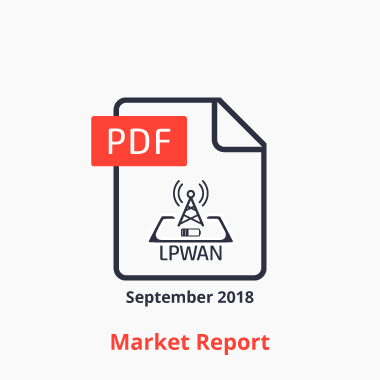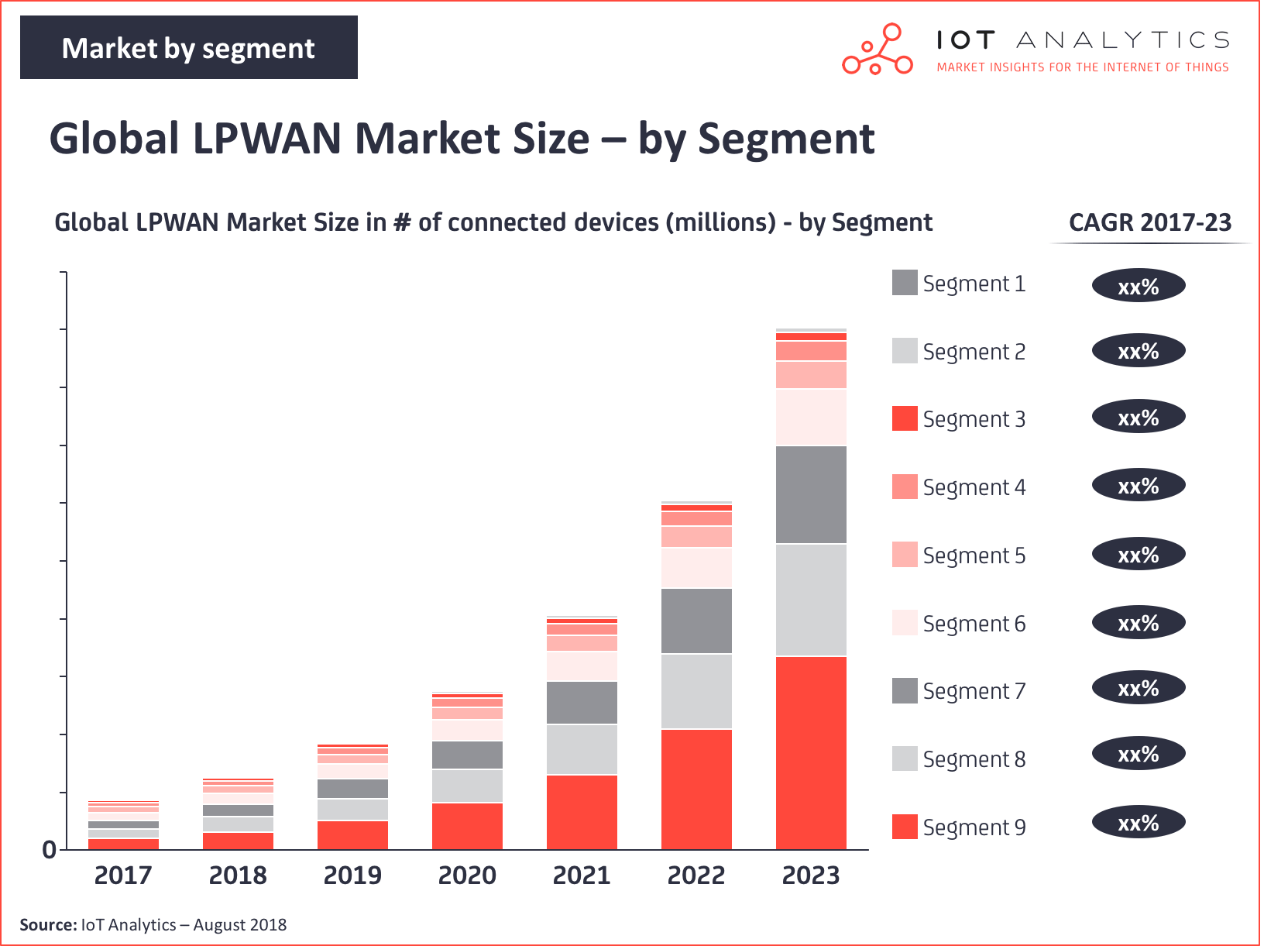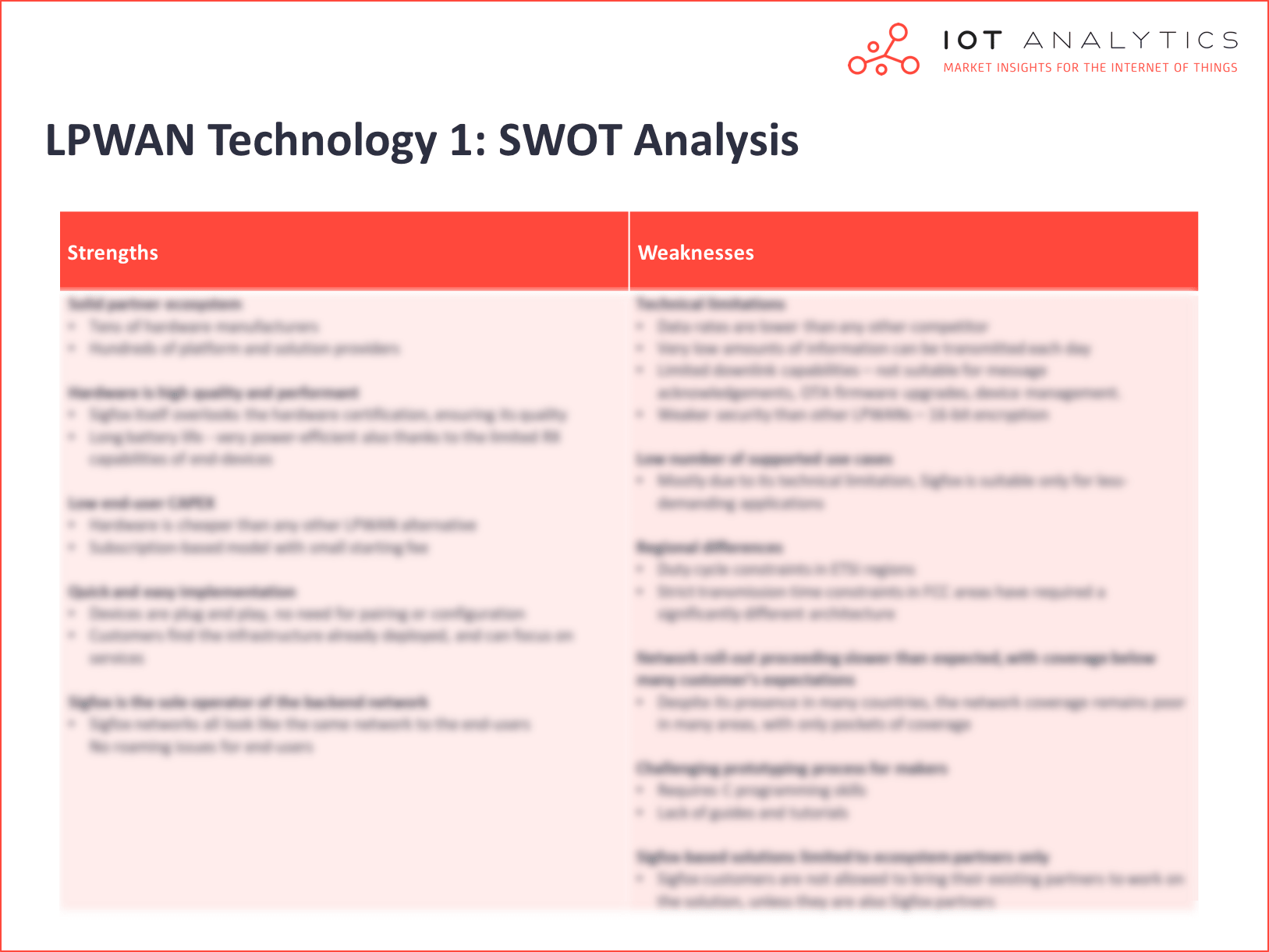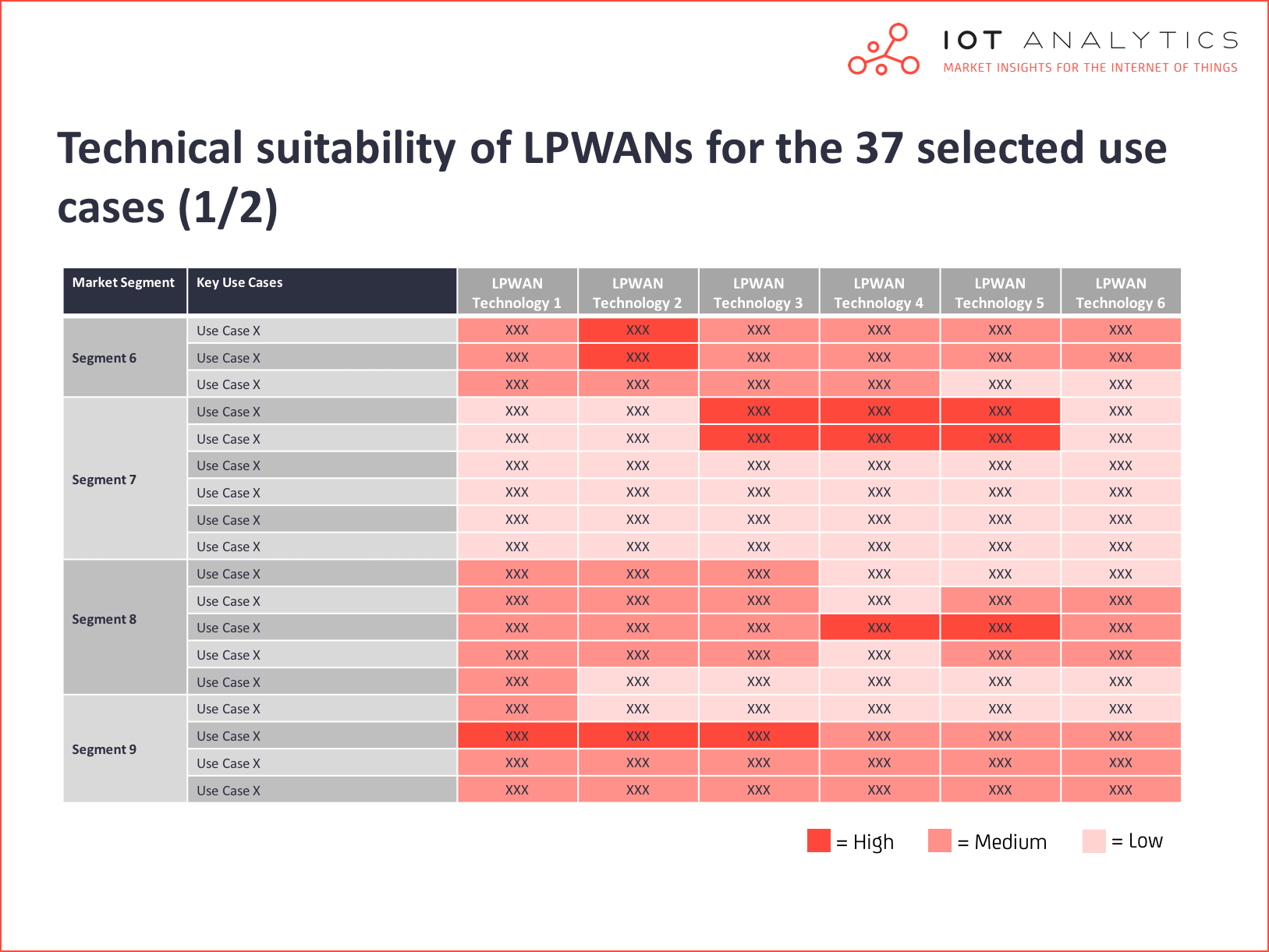Executive Summary
1 Introduction to LPWAN Networks
1.1 LPWAN design goals
1.1.1 Techniques to achieve LPWAN design goals
1.2 Historical background
1.3 Comparing LPWAN Networks to existing wireless technologies
1.3.1 Short-Range Wireless Networks
1.3.2 Medium-Range Wireless Networks
1.3.3 Cellular Networks
1.3.4 Satellite Networks
1.4 LPWAN position in the IoT Tech Stack
2 Fundamental wireless concepts of LPWAN
2.1 Radio Spectrum Licensing
2.2 IoT network topology
2.2.1 LPWAN Connectivity architecture
2.3 Link Budget
2.3.1 Overview & Definition
2.3.2 Technical details
2.4 Receiver Sensitivity
2.4.1 Overview & Definition
2.4.2 Technical Details
2.5 Signal-to-Noise Ratio (SNR)
2.5.1 Overview & Definition
2.5.2 Technical Details
2.6 Channel capacity
2.6.1 Overview & Definition
2.6.2 Technical Details
2.7 Modulation
2.7.1 Overview & Definition
2.7.2 Technical details
2.8 Bandwidth Occupancy
2.8.1 Overview & Definition
2.8.2 Observations on LPWAN bandwidth occupancy
2.9 Spread Spectrum Techniques
2.9.1 Overview & Definition
2.9.2 Technical Details
2.10 Multiple access protocols
2.10.1 Overview & Definition
© 2018 IoT Analytics. All rights reserved. iv
2.10.2 Classification of multiple access protocols for wireless channels
3 Overview of current LPWAN Technologies
3.1. Sigfox
3.1.1 Description
3.1.2 Technical Overview
3.1.3 Business Model/Go-to-market strategy
3.1.4 Ecosystem
3.1.5 SWOT Analysis
3.2. LoRa
3.2.1 Description
3.2.2 Technical Details
3.2.3 Business Model/Go-to-market strategy
3.2.4 Ecosystem
3.2.5 SWOT analysis
3.3 RPMA (Ingenu)
3.3.1 Description
3.3.2 Technical Details
3.3.3 Business Model/Go-to-market strategy
3.3.4 Ecosystem
3.3.5 SWOT Analysis
3.4 Weightless
3.4.1 Description
3.4.2 Technical Overview
3.4.3 Business Model/Go-to-market strategy
3.4.4 Ecosystem
3.4.5 SWOT analysis
3.5 LTE-M
3.5.1 Description
3.5.2 Technical Overview
3.5.3 Business Model/Go-to-market strategy
3.5.4 Ecosystem
3.5.5 SWOT analysis
3.6 NB-IoT
3.6.1 Description
3.6.3 Business Model/Go-to-market strategy
3.6.4 Ecosystem
3.6.5 SWOT analysis
3.7 EC-GSM-IoT
3.7.1 Description
3.7.2 Technical Overview
3.7.3 Business Model/Go-to-market strategy
3.7.4 Ecosystem
© 2018 IoT Analytics. All rights reserved.
3.7.5 SWOT analysis
3.8 Other relevant technologies
3.8.1 Secondary LPWAN technologies
3.8.2 Non-LPWAN technologies
4 LPWAN Applications and Use Cases
4.1 General Analysis of application requirements
4.2 Analysis of LPWAN application suitability
4.2.1 Agriculture & Forestry
4.2.2 Building & Infrastructure
4.2.3 Healthcare
4.2.4 Home & Consumer
4.2.5 Industrial
4.2.6 Retail
4.2.7 Smart City
4.2.8 Transportation, Supply Chain and Logistics
4.2.9 Utilities
4.3 Selected Case Studies and success stories
4.3.1 Agriculture: Precision Viticulture with LoRa
4.3.2 Healthcare: Assisted Living
4.3.3 Consumer: Shared Bicycle
4.3.4 Industrial: Digital Oilfield with RPMA
4.3.5 Smart City: Connected Street Lighting
4.3.6 Smart City: Smart Parking
4.3.7 Smart City: Waste Management
4.3.8 Supply Chain: Cold Chain Food Traceability with LoRa
4.3.9 Utilities: Smart Water Metering with NB-IoT
4.3.10 Utilities: Smart Energy Metering
5 Market dynamics, sizing and outlook
5.1 Market Overview
5.1.1 Market evolution in three phases
5.1.2 Other industry trends
5.2 Overall Market
5.2.1 Global Market Revenues
5.3 Market by technology
5.3.1 Connections by Spectrum type
5.3.2 Connections by LPWAN Technology
© 2018 IoT Analytics. All rights reserved.
5.3.3 Connections by Network Deployment type
5.4 Market by Segment
5.4.1 Overview
5.4.2 Agriculture & Forestry
5.4.3 Buildings & Infrastructure
5.4.4 Healthcare
5.4.5 Home & Consumer
5.4.6 Industrial
5.4.7 Retail
5.4.8 Smart Cities & Communities
5.4.9 Transportation, Supply Chain & Logistic
5.4.10 Utilities
5.5 Market by Region
5.5.1 North America
5.5.2 Europe
5.5.3 Asia Pacific (APAC)
5.5.4 Latin America
5.5.5 Middle East & Africa
Appendix
A. Research Methodology and Market Sizing
B. List of Exhibits
C. List of Tables
D. List of Acronyms
About
Selected recent publications
Upcoming publications
Subscription
Newsletter
Author
Contact Us
Copyright
B. List of Exhibits
Exhibit 1: Fundamentals of LPWAN technologies
Exhibit 2: Positioning of wireless technologies based on their peak data rate and maximum
theoretical communication range (Source: IoT Analytics)
Exhibit 3: The technology stack of the Internet of Things (Source: IoT Analytics)
Exhibit 4: Distribution of network nodes in star and mesh network topologies
Exhibit 5: Typical LPWAN end-to-end communication architecture
Exhibit 6: Example of link budget calculation along the radio path between a transmitter and
a receiver
Exhibit 7: Performance comparison of different digital modulation schemes
Exhibit 8: Example showing the difference between analog (a) and digital (b) modulations of a
carrier’s amplitude
Exhibit 9: Example showing how spread spectrum techniques modify a signal’s power density
and bandwidth occupancy (Source: Internet search)
Exhibit 10: High level overview of current LPWAN and comparative technologies
Exhibit 11: Sigfox’s “Flat” Network Architecture (Source: Sigfox)
Exhibit 12: LoRaWAN protocol stack (Source: LoRa Alliance)
Exhibit 13: Structure of a LoRaWAN packet (Source: LoRa Alliance)
Exhibit 14: Overall ranking of LPWAN technologies based on their level of suitability over the 37
selected use cases
Exhibit 15: LPWAN Market evolution in three phases.
Exhibit 16: Global LPWAN connections 2017-2023 (Source: IoT Analytics)
Exhibit 17: Global LPWAN market revenues 2017-2023 (Source: IoT Analytics)
Exhibit 18: Global LPWAN connections by spectrum type (Source: IoT Analytics)
Exhibit 19: Global LPWAN connections by technology type 2017-2023 (Source: IoT Analytics)
Exhibit 20: Global LPWAN market shares by technology, 2017-2023 (Source: IoT Analytics)
Exhibit 21: Global LPWAN connections by network deployment type 2017-2023
(Source: IoT Analytics)
Exhibit 22: Global market shares of public LPWAN connections, 2017-2023 (Source: IoT Analytics)
Exhibit 23: Global market shares of private LPWAN connections, 2017-2023 (Source: IoT Analytics)
Exhibit 24: LPWAN Market shares by technology and market segment in 2017 (Source: IoT Analytics)
Exhibit 25: Global LPWAN connections by market segment, 2017-2023 (Source: IoT Analytics)
Exhibit 26: Global LPWAN connections within the Agriculture & Forestry segment, 2017-2023
(Source: IoT Analytics)
Exhibit 27: Global LPWAN connections within the Buildings & Infrastructure segment,
2017-2023 (Source: IoT Analytics)
Exhibit 28: Global LPWAN connections within the Healthcare segment, 2017-2023
(Source: IoT Analytics)
Exhibit 29: Global LPWAN connections within the Home & Consumer segment, 2017-2023
(Source: IoT Analytics)
Exhibit 30: Global LPWAN connections within the Industrial segment, 2017-2023
(Source: IoT Analytics)
Exhibit 31: Global LPWAN connections within the Retail segment, 2017-2023 (Source: IoT Analytics)
Exhibit 32: Global LPWAN connections within the Smart Cities & Communities segment,
2017-2023 (Source: IoT Analytics)
Exhibit 33: Global LPWAN connections within the Transportation, Supply Chain & Logistics
segment, 2017-2023 (Source: IoT Analytics)
Exhibit 34: Global LPWAN connections within the Utilities segment, 2017-2023
(Source: IoT Analytics)
Exhibit 35: LPWAN Market shares by technology and region in 2017 (Source: IoT Analytics)
Exhibit 36: Global LPWAN connections by region, 2017-2023 (Source: IoT Analytics)
Exhibit 37: LPWAN Connections in North America, 2017-2023 (Source: IoT Analytics)
Exhibit 38: LPWAN Connections in Europe, 2017-2023 (Source: IoT Analytics)
Exhibit 39: LPWAN Connections in Asia Pacific, 2017-2023 (Source: IoT Analytics)
Exhibit 40: LPWAN Connections in Latin America, 2017-2023 (Source: IoT Analytics)
Exhibit 41: LPWAN Connections in Middle East & Africa, 2017-2023 (Source: IoT Analytics)
C. List of Tables
Table 1: Overview of the 10 wireless concepts discussed in this chapter
Table 2: Pros and cons of star and mesh networks
Table 3: Pros and Cons of the different digital modulation schemes
Table 4: Pros and Cons of Narrowband and Wideband Systems
Table 5: High level comparison of the main LPWAN technologies
Table 6: List of 20 key vendors of Sigfox products and solutions
Table 7: List of 15 key Sigfox Network Operators
Table 8: SWOT analysis of Sigfox
Table 9: List of 20 key vendors of LoRa products and solutions
Table 10: List of key LoRaWAN Network Operators
Table 11: SWOT Analysis of LoRa
Table 12: List of 20 key vendors of RPMA products and solutions
Table 13: List of 5 known RPMA public operators
Table 14: SWOT Analysis of RPMA
Table 15: SWOT Analysis of Weightless
Table 16: List of 13 key vendors of LTE-M products and solutions
Table 17: List of 12 key LTE-M Network Operators
Table 18: SWOT Analysis of LTE-M
Table 19: List of 20 key vendors of NB-IoT products and solutions
Table 20: List of 28 key NB-IoT network operators
Table 21: SWOT Analysis of NB-IoT
Table 22: List of the 17 companies supporting the development of EC-GSM
Table 23: SWOT Analysis of EC-GSM
Table 24: Comparison table of other LPWAN technologies (1 out of 3)
Table 25: Comparison table of other LPWAN technologies (2 out of 3)
Table 26: Comparison table of other LPWAN technologies (3 out of 3)
Table 27: Comparison table of non-LPWAN technologies addressing similar use cases (1 out of 2)
Table 28: Comparison table of non-LPWAN technologies addressing similar use cases (2 out of 2)
Table 29: Definitions and possible values of the criteria used to analyse application
requirements (1-6) (Source: IoT Analytics)
Table 30: Definitions and possible values of the criteria used to analyse application
requirements (7-12) (Source: IoT Analytics)
Table 31: General application requirements of the analysed market segments (1-5)
(Source: IoT Analytics)
Table 32: General application requirements of the analysed market segments (6-9)
(Source: IoT Analytics)
Table 33: Technical suitability of LPWANs for the selected key use cases (market segments 1-5)
Table 34: Technical suitability of LPWANs for the selected key use cases (market segments 6-9)
Table 35: Application requirements of key use cases within the Agriculture & Forestry market
segment (Source: IoT Analytics)
Table 36: Technical Suitability of LPWANs for key Agriculture & Forestry use cases
(Source: IoT Analytics)
Table 37: Application requirements of key use cases within the Building & Infrastructure
market segment (Source: IoT Analytics)
Table 38: Technical Suitability of LPWANs for key Building & Infrastructure use cases
(Source: IoT Analytics)
Table 39: Application requirements of key use cases within the Healthcare market segment
(Source: IoT Analytics)
Table 40: Technical Suitability of LPWANs for key Healthcare use cases (Source: IoT Analytics)
Table 41: Application requirements of key use cases within the Home & consumer market
segment (Source: IoT Analytics)
Table 42: Technical Suitability of LPWANs for key Home & Consumer use cases
(Source: IoT Analytics)
Table 43: Application requirements of key use cases within the Industrial market segment
(Source: IoT Analytics)
Table 44: Technical Suitability of LPWANs for key Industrial use cases (Source: IoT Analytics)
Table 45: Application requirements of key use cases within the Retail market segment (Source:
IoT Analytics)
Table 46: Technical Suitability of LPWANs for key Retail use cases (Source: IoT Analytics)
Table 47: Application requirements of key use cases within the Smart City market segment
(Source: IoT Analytics)
Table 48: Technical Suitability of LPWANs for key Smart City use cases (Source: IoT Analytics)
Table 49: Application requirements of key use cases within the Transportation, Supply Chain
and Logistics market segment (Source: IoT Analytics)
Table 50: Technical Suitability of LPWANs for key Transportation, Supply Chain and Logistics
use cases (Source: IoT Analytics)
Table 51: Application requirements of key use cases within the Utilities market segment
(Source: IoT Analytics)
Table 52: Technical Suitability of LPWANs for key Utilities use cases (Source: IoT Analytics)
Table 53: Overview of the 10 analysed case studies
Table 54: General information on the analyzed case study
Table 55: List of companies and institutions publicly involved in the case study
Table 56: General information on the analyzed case study
Table 57: List of companies and institutions publicly involved in the case study
Table 58: General information on the analyzed case study
Table 59: List of companies and institutions publicly involved in the case study
Table 60: General information on the analyzed case study
Table 61: List of companies and institutions publicly involved in the case study
Table 62: General information on the analyzed case study
Table 63: List of companies and institutions publicly involved in the case study
Table 64: General information on the analyzed case study
Table 65: List of companies and institutions publicly involved in the case study
Table 66: General information on the analyzed case study
Table 67: List of companies and institutions publicly involved in the case study
Table 68: General information on the analyzed case study
Table 69: List of companies and institutions publicly involved in the case study
Table 70: General information on the analyzed case study
Table 71: List of companies and institutions publicly involved in the case study
Table 72: General information on the analyzed case study
Table 73: List of companies and institutions publicly involved in the case study





















